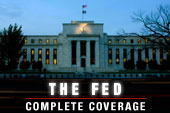What better backdrop than the Grand Tetons to remind Federal Reserve Board Chairman Ben Bernanke of the looming fiscal cliff as he addresses his colleagues to their annual retreat tomorrow in Jackson Hole, Wyoming. All will be waiting for his next move in the face of a sluggish economy, an election that could change the course of the country, and global events that could derail the fragile recovery.
The minutes of the last Federal Open Markets Committee meeting on July 31-August 1 noted that “many members judged that additional monetary accommodation would likely be warranted fairly soon unless incoming information pointed to a substantial and sustainable strengthening in the pace of the economic recovery.”
Seen any evidence of substantial and sustainable strengthening lately?

Sure the latest data on personal income, consumer spending and home prices revealed a very modest rebound is still underway. A traditional summer rally in stocks (the Dow Jones Industrial Average at the end of Thursday’s trading was up about 6.4 percent since the beginning of the year) has alleviated fears that the economy may be stalling.
But with unemployment stuck at 8.3 percent and most economists predicting growth in the second half at or below last quarter’s ho-hum 1.8 percent, the annual gathering of central bankers and economists at Jackson Hole, Wyoming would seem like the ideal place to signal the Fed will soon step on the gas and give the economy another shot of monetary easing. That would probably entail a third round of Fed bond purchases to bring down long-term interest rates, which are already extremely low by historical standards.
Yet no one expects Bernanke to send that signal on Friday. At most, professional Fed watchers say, he will reiterate the positions that he spelled out after his last non-action, which is that the Fed is prepared to act, but not now. He might throw a feather to the easing doves by suggesting the current ultra-low interest rate policy will remain in place through 2015, a year longer than the current target.
So the obvious question, given Americans hunger for jobs, is why? Why not send a clear signal that the Fed will soon take further actions to turn this paltry rebound into sustainable growth of 3.0 percent or more, the level required to significantly bring down the unemployment rate?
There are several possible reasons for Bernanke’s hesitation. First, there are risks, and not the idle chatter of gold bugs and monetary hawks who claim the Fed will provoke rapid inflation by constantly pumping new money into the economy. Prices, other than oil and food, have remained remarkably stable in recent years.
Rather, the Fed is concerned the extra cash may wind up doing nothing more than artificially pumping up asset prices, primarily stocks. There’s no upside to creating an asset bubble in securities that may already be overpriced given the state of the underlying economy.
Second, it might not work. External shocks had a nasty way of undermining previous Fed actions.
Two years ago, Bernanke used the Jackson Hole confab to signal a second round of so-called quantitative easing. The first had been launched in the midst of the financial crisis and pursued through October 2009. Coupled with the Obama administration stimulative spending policies, the economy by mid-2010 appeared on track for a rapid rebound from the worst downturn since the Great Depression.
But then the news turned ugly. The Euro-zone entered a prolonged and politically divisive fiscal and banking crisis. Austerity budgets in Great Britain brought its economic recovery to a standstill. Similar pressures began mounting in the U.S., which culminated in the 2010 mid-term election where Republicans pledged to impose sharp cuts in government spending and won control of the House of Representatives.
To counteract those headwinds, Bernanke signaled the second round of easing, which began in November. It sent hopes soaring for a more robust 2011. President Obama’s post-election emergency “jobs” package – its centerpiece, a 2 percentage point payroll tax reduction, garnered bipartisan support – added to expectations that millions of out-of-work Americans would soon find jobs.
It wasn’t to be. As 2011 progressed, oil prices soared, the Japanese tsunami disrupted the global supply chain and Congress engaged in brinkmanship over the debt ceiling, which undermined business and consumer confidence. The August deal forced on the president by the House – nearly $100 billion a year in reduced spending – turned government fiscal policy into an economic drag.
Meanwhile, Republicans in Congress and on the early campaign trail threatened the Fed chairman with retaliation if he took additional steps to help the economy. In the wake of those multiple shocks, the economy and job growth in the election year slowed to near stall speed.
As Bernanke likes to point out at his quarterly press conferences, the Fed is not out of ammunition. Yes, short-term interest rates – the ones the Fed controls directly – are near zero.
But through another round of purchasing mortgage-backed securities and tinkering with the mix of Treasury bonds and MBSs in its portfolio, the Fed could lower the rate on 10-year Treasuries by as much as 100 basis points to less than 1 percent. That in turn would lower conventional mortgage rates to as low as 2.5 percent – a full point below their already historically low levels. That would provide a huge boost to the housing market, which continues to be the biggest sore spot in the economy.
So why not act now? Bernanke has repeatedly testified on Capitol Hill that monetary policy is no panacea in an environment where government spending policies are working at cross-purposes. He supports a long-term plan to bring the yawning budget deficit under control, but says those plans should not include measures that detract from short-term growth while the economy is still trying to achieve flying altitude.
Yet that’s not the path Congress chose. Government jobs are evaporating while the biggest shock of all looms after the November election. The fiscal cliff – legislatively-mandated across-the-board spending cuts coupled with expiration of all the Bush-era tax cuts and other measures – threatens to pull nearly $500 billion out of the economy next year.
While the Fed may not be out of ammunition, there may be a growing mood among members of the FOMC that it is better to hold fire until the lame duck or next Congress decides what level of fiscal austerity it wants to impose on the economy. “The Fed has always rejected the “save your ammunition” argument, figuring that if we’re worried about a fiscal cliff, we should get the economy moving faster now so it can sail along the edge of that cliff rather than falling over it,” said Joseph Gagnon, a senior fellow at the Peterson Institute for International Economics and a former Fed economist.
“But that might be changing,” he said. “They’ve never been this close to running out of ammunition. Maybe now they’re worried about running out.”





